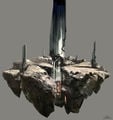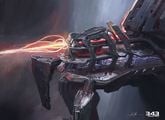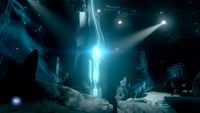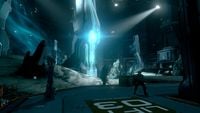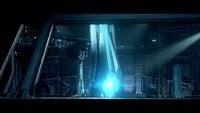Composer
From Halopedia, the Halo wiki
- "The Composer! So many possibilities and capabilities tied up in that strange name... A Composer of minds and souls!"
- — Forthencho, Lord of Admirals[1]
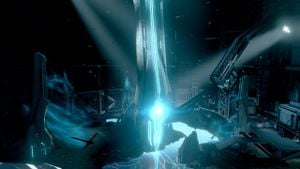
Composers were ancient Forerunner machines capable of converting living beings into digital forms.[2] The scheme was among the first of the countless plans laid by the Forerunners to defeat the Flood.[3]
Overview and function
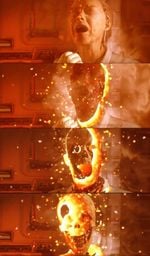
After the Forerunners first discovered the existence of the Flood parasite in the later stages of the Human-Forerunner War, the Forerunners quickly began to devise plans to combat the infection should it resurface. The Composers were one of the first solutions proposed by the Builders. The original function of the machines was to save Flood victims by extracting their mental patterns - or essences - and translating them to data by broadcasting high-energy fields of entangled sympathies. The stored essence would then be imprinted on a new, artificially constructed biological body devoid of Flood infection. However, the process was highly flawed. All attempts to restore the essences to biological form failed as the artificial bodies would quickly decay and inevitably die.[3] For this reason, the Forerunners quickly abandoned the Composers after the first experiments.[4]
Despite the failure of the original plan, the Forerunners found other uses for the Composers. Although the Forerunners possessed other technologies capable of extracting an individual's memories and personality impressions,[5] only Composers were given to the Librarian and her Lifeworkers when they were tasked with extracting the essences of the human survivors on Charum Hakkor; powerful forces in the Old Council - mainly Builders - wanted to make sure the fate of their enemies would be as cruel as possible.[3] The Librarian implanted these stored personalities into the genetic code of living humans, with said personalities achieving self-awareness and retaining their original identity within their new human hosts, such as Chakas and Riser. The Composer could also be used to remove these imprinted personalities, although this did grave physical and mental damage to the individual carrying the imprint.[6]
The Composer did not work on all organic beings; certain individuals could, through genetic manipulation, become immune to its effects. After undergoing and experimental mutation in an attempt to gain immunity to the Flood, the Ur-Didact's physiology was no longer compatible with the Composer.[7] Similarly, the geas the Librarian placed on humanity allowed the Spartan John-117 to develop a resistance to the Composer; this ability had to be activated, and thus it did not automatically protect all humans from the device.[8]
The physical effects of the Composer on its targets appear to have been varied; when the Didact fired the Composer directly on humans, the device projected a beam of orange light which completely reduced the targets to ash in a rather gruesome and painful manner while their minds were digitized. Aside from this direct form of scanning, the Composer was also capable of a less violent method of extraction. When the Librarian and her Lifeworkers used the Composer indirectly via intermediary devices, the bodies of the targeted individuals were not destroyed and instead the scan caused them to expire as their consciousnesses were removed from their bodies.[9]
Minds scanned by the Composer could be processed in a variety of ways. Although the ancient human personalities extracted and stored by the Librarian were retained in their original essences, in some cases the digitized neural map could be used as the basis for artificial intelligence constructs in a manner similar to the creation of human smart AIs. These intelligences would contain many of their original memories and sometimes even portions of their personality, but would otherwise behave within the limits of the duties assigned to them. For example, the Promethean Knights behave in a largely uniform manner despite containing at least some of the memories of the individuals they were created from.[10]
The Composer also possessed a secondary capability of slowing down Flood infection and the subsequent loss of individuality. However, this process was only temporary and still left the afflicted individuals in their deformed state. This was accomplished through wrapping the infected bodies in a form of supportive harness flowing with energy, evidently somehow connected to the Composer.[11]
History
Composers were given by the Council to the Librarian and the Lifeworkers to extract the memories of the surviving human warriors after the Charum Hakkor campaign. These personalities would be preserved in future generations of humans and to study the stored memories in hopes of discovering how humanity managed to defeat the Flood. The Lord of Admirals, the supreme commander of all human forces and one of the humans to have their minds harvested, described the effects of the Composer as "strange, ever-changing" and "multiformed", as it operated via intermediary Lifeworker machinery.[9]
As a result of the risks and irregularities involved with their usage, the Forerunners eventually abandoned the Composers and their existence was made a closely guarded secret known to only a few.[4] Even the fact that there were once many Composers was unknown to most by the time of the Forerunner-Flood war, with the general assumption being that only a single Composer ever existed. Even the machines' actual nature remained obscure; whether it was a machine or being remained uncertain to most. Some even believed the Composer to be a "product of its own services"; a Forerunner, perhaps a Lifeworker, suspended in the final stages of Flood infection.[12][13]
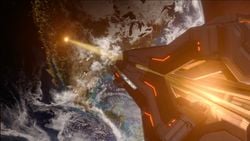
Around 100,000 BCE, the Composer was used by Master Builder Faber to stave off Flood infection in certain Forerunners on Installation 07 to keep them in a docile state. While in control of Installation 07, Mendicant Bias and the Primordial also used the Composer to extract the ancestral memory imprints from Chakas and the other humans from Erda.[6] Later during the Forerunner-Flood war, the Didact used the Composer to convert his Promethean warriors into robotic forms to allow them to combat the Flood more efficiently and without risk of infection. To bolster his numbers, the Didact used the Composer on a number of humans transplanted to Omega Halo, turning them into additional forces in his mechanized army.[7]
The Composer was later placed on Halo Installation 03. In late 2554,[14] the UNSC Office of Naval Intelligence discovered the machine on the Halo ring and transported it to Ivanoff Station, a research facility in the asteroid field in Installation 03's orbit. The machine was partially buried within the installation's surface and remained embedded in a large chunk of rock when the UNSC transported it to Ivanoff. Some of the scientists were digitized by the Composer while studying it and the sensor data from the incident contained coordinates that led the UNSC Infinity to Requiem.[15] Upon awakening on Requiem in July 2557, the Didact immediately headed for the Composer and acquired the device after launching an attack on Ivanoff Station. Planning to use the Composer to neutralize all of mankind by forever imprisoning them into digital form, he first used it on the human personnel of Ivanoff; Spartan John-117 was the only survivor as a result of genetic modifications imbued by the Librarian. The Didact then set course for Earth in order to realize the final stage of his plan. He successfully fired the Composer on a URNA metropolis, New Phoenix, but the effect was halted when John-117 destroyed the Didact's ship, and the Composer along with it, with a HAVOK tactical nuclear weapon.[2] Some of the resulting digital intelligences survived, having ended up on Requiem via a slipspace transit portal connected to the Composer.[10]
Gallery
Concept art of one of the shield generators around the Composer on the level Midnight.
Dr. Sandra Tillson undergoing the fatal effects of the Composer.
The Composer integrated to the Didact's ship, Mantle's Approach.
List of appearances
- Halo: Primordium (First appearance)
- Halo 4
- Halo: Silentium
Sources
- ^ Halo: Primordium, page 232-233
- ^ a b Halo 4
- ^ a b c Halo: Silentium, String 3
- ^ a b Halo: Primordium, page 271-272
- ^ Halo: Cryptum, pages 47-48, 138
- ^ a b Halo: Primordium, page 355
- ^ a b Halo 4, Terminals
- ^ Halo 4, campaign level Reclaimer
- ^ a b Halo: Primordium, page 235
- ^ a b Spartan Ops, S1E5 Memento Mori
- ^ Halo: Primordium, page 322-323
- ^ Halo: Primordium, page 268
- ^ Halo: Primordium, page 278
- ^ Halo 4, campaign level Composer, audio log
- ^ Halo 4, campaign level Infinity
| ||||||||


